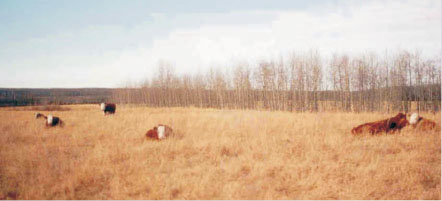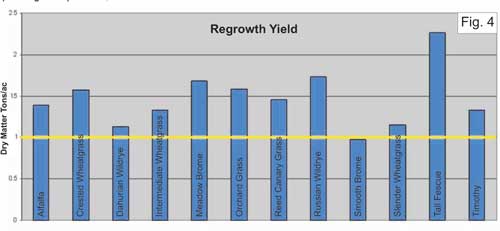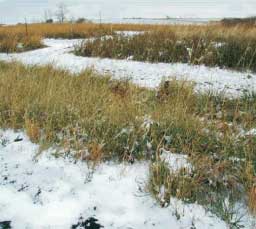Stockpiled Forages

What is stockpiled forage?
Stockpiled forage is the term given to pasture saved for grazing after the summer growing season. Stockpiled forage can be used from October through to early December, or until weather or snow conditions inhibit grazing. Stockpiled forage can also be used early in the spring before new growth pasture is available.
Why use stockpiled forage?
On the Canadian prairies, winter feed is the primary cost of production of a typical cow herd. One strategy to reduce feed costs is to lengthen the grazing season, since costs on pasture are about 50 percent of those for stored feeds.
Is stockpiled forage quality adequate when grazing beyond the typical grazing season?
Three years of forage testing in Southwestern Manitoba shows that stockpiled grass has adequate nutritional quality from October to December for dry, mature cows in early to mid gestation. Stockpiled alfalfa has adequate nutritional quality from October until the end of November. Alfalfa quality is dependent on leaf retention. For instance, once alfalfa sheds its leaves, forage quality declines rapidly. The nutritional value of stockpiled forage used in March and April is below the minimum requirements of all classes of cattle. Therefore, supplementation is required.
Getting good forage quality
Forage research has consistently shown that the more mature the forage is allowed to grow, the poorer the quality becomes. Fully mature forages will be too low in nutritional quality to maintain a dry cow. To ensure adequate quality, the forage must be harvested through grazing or haying in mid summer, and then allowed to regrow for grazing late in the season. The stockpiled regrowth is nutritionally higher quality feed than the fully mature forage that has not been harvested mid-season.
What class of livestock should be grazed on stockpiled forage?
Stockpiled forage is primarily for mature dry cows in early to mid gestation. Stockpiled forage will rarely meet the nutritional requirements of young growing stock, early lactation cows, or thin cows, particularly as the season progresses and/or under inclement weather conditions.
Total digestible nutrients in stockpiled forages
The total digestible nutrients (TDN) of stockpiled forages typically decline over the winter (Figure 1). This was most evident for alfalfa in this study, where quality declined by early December to levels below that needed for dry cows in early to mid gestation. However, all of the grasses tested retained adequate TDN levels (>50%) over the winter and spring periods for this class of animal. Some grasses also maintained sufficient TDN levels (60 to 65%) to maintain milk production in cows, however by October most grasses did not have enough TDN to maintain a weight gain of two pounds per day in growing stock animals.

Crude protein in stockpiled forages
A dry cow in early to mid gestation requires 7 to 8 % crude protein (CP) for maintenance (Figure 2). Forage regrowth has good levels of protein for dry cows and cows in late lactation. However, young growing stock and early lactation cows require 11 to 13 % CP. By mid-October, most of the forages have insufficient CP for growing stock and early lactation cows. While the CP of the grasses drops slowly over the winter, alfalfa's protein drops rapidly between October and December due to leaf drop.

Relative feed value of stockpiled forages
Dry cows in early to mid gestation require a relative feed value (RFV) of 80. Lactating cows require RFV values between 100 to 123, and growing stock require RFV values between 124 and 140. Figure 3 shows that all of the forages are adequate for dry cows until the end of November. Some of the forages are adequate for late lactation cows, however by late October none of the forages are adequate for growing stock. All classes of livestock will require supplemental feed if stockpiled forage is to be used in March or April.

Regrowth yield of stockpiled forages
Cows will be working harder for their feed during the fall compared to summer, especially when inclement weather and snow affect intake levels. Therefore, the cows should be presented with at least one ton of dry matter forage per acre. Harvesting early in the summer will provide more forage for grazing in the fall, however the forage will be poorer quality due to later maturity. Harvesting late in the summer will provide excellent forage quality, but will provide too little regrowth for efficient grazing. In most areas of Manitoba, harvesting near July 15th will give you the best balance between quality and quantity.
Yield is highly variable between years. Figure 4 shows the average regrowth yields over three years of sampling. Some years, the forages yielded below one ton/acre and in other years they all yielded over one ton/acre. The forages known for good regrowth potential, such as meadow brome, orchard grass, alfalfa and tall fescue, consistently gave better regrowth yields than those with poor regrowth potential, such as smooth brome.

How much forage should be left behind?
In general, about 1000 Ibs/acre should remain after grazing the stockpiled forage; this is about three to four inches of forage residue. This is due to several factors. Firstly, grazing beyond this point will limit a cow's daily dry matter intake. Limiting intake will result in declining body condition, regardless of the forage quality. Secondly, leaving this amount of residue will maintain forage stand health. Crop residue conserves soil moisture, protects the soil from erosion and increases nutrient cycling. Both result in increased or improved stand longevity and vigor.
Forage Structure
Plant structure is important if livestock will be grazed through some snow cover. Soft grasses such as meadow brome and orchard grass tend to lay down under the weight of snow, but forages such as tall fescue and Russian wild rye stand up and are more easily found by the livestock. Grazing the soft grasses earlier in the fall will reduce the risk of the forages being buried and lost under snow cover.

Meadow Brome 3250 lbs/acre

Tall Fescue 4050 lbs/acre
Conclusions
Stockpiled forage has adequate nutritional value for dry cows in early to mid gestation. In some years, quality will be sufficient for cows in late lactation, but rarely will stockpiled forage be adequate for young growing stock or early lactation cows. Under Manitoba conditions, stockpiled forage may extend the grazing season into November and early December. Because the quality of the alfalfa declines rapidly between October and December, optimum use of this forage will occur between October and the end of November. The nutritional value of stockpiled forage used in March and April is below the requirements of all classes of cattle, therefore, supplementation is required.
Figures presented are averages over three years of sampling. It should be noted that nutritional quality and yield can vary significantly between years and sites. Feed testing of your own stockpiled forages is recommended.
